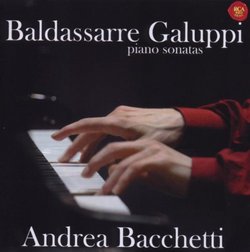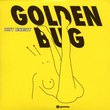| All Artists: Galuppi, Bacchetti Title: Piano Sonatas Members Wishing: 0 Total Copies: 0 Label: RCA Red Seal Release Date: 10/28/2008 Album Type: Import Genre: Classical Styles: Chamber Music, Historical Periods, Classical (c.1770-1830) Number of Discs: 1 SwapaCD Credits: 1 UPC: 886973679326 |
Search - Galuppi, Bacchetti :: Piano Sonatas
CD DetailsSimilar CDs
|
CD ReviewsSome beautiful moments, but better ingested in small doses Discophage | France | 06/04/2009 (4 out of 5 stars) "I had pinned high hopes on this Galuppi recital. I'm always thrilled to hear unfamiliar 18th Century keyboard music played on the piano. I've recently reviewed such recitals of Rameau and Couperin (see for intance Alexandre Tharaud plays Rameau, Alexandre Tharaud plays Couperin ~ tic, toc, choc; there's also one of Haendel's suites by Vahan Mardirossian on Intrada that unfortunately is not listed on this website, see asin B0002OVQE8 on the French sister company), and they were equally endearing. Scarlatti and Bach of course are customary ground for pianists, but Haendel, Couperin and Rameau aren't so much, still today. Yet, I find them equally convincing (as Bach and Scarlatti I mean) when played on the modern instrument, to make me wonder why pianists leave them to the harpsichordists. As for the composers of the second half of the 18th Century, Haydn and Mozart are, just like Scarlatti and Bach, as much part of the pianistic mainstream as the Romantics, but it is always nice and revealing to explore the byways and the minor masters, and sometimes it offers great rewards. Years ago I bought a 2-CD set of the complete sonatas of Cimarosa and it was a marvel, an unexpected and endearing mixture of Scarlatti and Haydn (Domenico Cimarosa: Complete Sonatas).
Baldassare Galuppi was a Venetian composer, mainly noted for his large output in opera and his collaborations with Goldoni who wrote many a libretto for him, some of which that were re-used by subsequent composers (like Il Mondo della Luna and Haydn). His dates - 1706 -1785 - make him part of a later generation than Bach, Vivaldi, Haendel and Scarlatti but of an older one than Haydn and Mozart, and roughly a contemporary of Bach's two eldest sons - Wilhelm-Friedemann and Carl-Philipp-Emmanuel. The Sonatas featured here are performed in a new edition from the original sources (usually contemporary copies rather than original manuscripts) by Mario Marcarini (who wrote the liner notes) and pianist Andrea Bacchetti (born in Genoa in 1977). Apparently, none can be dated with certainty. Stylistically, some are closer to the Scarlatti model and sound, both the slow and the fast movements, as if they could be late offshoots of Scarlatti Sonatas (1 to 5, track 11), and some sound like they could come out of a Haydn Sonata (6 to 9 for instance). Track 10, the first movement of Sonata in a-minor, is a simple Siciliana that sounds as if it could pre-date Bach (Johann Sebastian, I mean). The two last Sonatas showcased on the CD offer the interesting peculiarity of sharing the same final presto - once made famous by Arturo Benedetti-Michelangeli, who made it one of his favored encores (Vol. 1: The Early Recordings). This shared movement is an effect of the unscrupulous habits of the publisher in those days, to cull and publish new works from the compilation of the most popular movements of other Sonatas, and in the present case the sources don't allow to establish which is the original version. Bachetti commendably varies the interpretation to suit the character of its respective first movement. Why then am I slightly disappointed with this Galuppi recital? It has much to do I think with the sonatas' formal structure. They do not yet follow the three-movement, fast-slow-fast classical model illustrated so brilliantly by Mozart and Haydn, but rather a two-movement slow-fast articulation. The fast movements are great, dynamic, boisterous, uplifting - everything that you love in Scarlatti. But those slow movements: they are indeed very "pretty", dreamy, pensive, wistful, and sometimes even beautiful - but very repetitive also, and all the more so when the "fast" movement is not a downright Allegro but an Allegretto as in the C minor Sonata (track 9), or when, in track 1 (the only one-movement Sonata in the recital), Bacchetti plays the indicated allegro as an andantino at best, giving it the character of a longing arietta (here, the liner notes support the approach by stating that despite the allegro instruction "the mood evoked is clearly melancholic and meditative", finding further argument in the resemblance of the opening theme with the beginning of the aria "Pupille amate" from Mozart's Lucio Silla). The same happens with track 14, but with less damage, as the Allegro is here indeed the first movement followed by a presto. The problem with these slow movements is also that oftentimes Galuppi seems to repeat endlessly a material that should have demanded more imaginative development (the record goes to track 12 with 10 minutes and track 2 with 8:16, but even the 3:51 of track one seem too long for its basic material). Editor Mario Marcarini seems to admit as much when he writes: "this is typical of Galuppi's style and demonstrates his ability to create moods of ecstatic suspension so that the discourse seems able to proceed only after repeated reflections on the same theme which undergoes changes that, although sometimes minimal, transform it in their simplicity". Well - read between the lines: repetition of the same, simple themes with minimal transformation. Warts and all, I think these slow movements wouldn't have conveyed the same, slightly bored feeling if they had come in between two fast ones, as moments of repose and meditation after a surge of adrenalin and in preparation for another one (and it is possibly that kind of consideration, conscious or intuitive, that led the classical composers to embrace the new formal structure). But here, there is simply too much meditative prettiness and not enough adrenalin. Nonetheless, this disc is likely to offer genuine pleasure to amateurs of 18th Century keyboard music. But I'd definitely recommend investigating first the Sonatas of Cimarosa. TT 68:50. The booklet features much-abridged liner notes, that can be found in their complete and thoroughly informative (if sometimes excessively wordy) form as pdf files in the CD. " |





